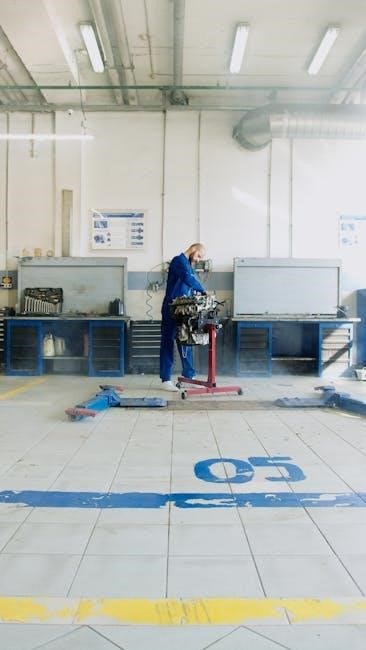manual transmission gearbox problems
Manual transmission gearbox problems can significantly impact vehicle performance and reliability. Common issues include slipping clutches, gear shifting difficulties, and transmission noises, often due to worn components or fluid leaks.
Overview of Common Issues
Manual transmission gearbox problems often manifest through noticeable symptoms that affect driving performance. The most frequent issues include slipping clutches, difficulty shifting gears, and unusual noises like grinding or ticking sounds. Additionally, leaks in transmission fluid and sticking clutch pedals are common concerns. These problems can arise from worn-out components, improper lubrication, or excessive wear and tear. Early detection is crucial, as neglected issues can lead to more severe damage, requiring costly repairs. Understanding these common problems helps drivers identify potential faults early, ensuring smoother and safer vehicle operation. Regular maintenance plays a key role in preventing these issues from escalating.
Importance of Early Detection
Identifying manual transmission issues early is vital to prevent minor problems from escalating into major repairs. Neglecting symptoms like unusual noises or difficulty shifting can lead to costly damage over time. Early detection allows for timely interventions, reducing the risk of breakdowns and ensuring safety on the road. Regular checks and prompt action can extend the lifespan of gearbox components and maintain optimal vehicle performance. Addressing issues early also minimizes the likelihood of requiring extensive overhauls, saving both time and money. Proactive maintenance is key to preserving the health and functionality of the manual transmission system.
Common Problems with Manual Transmission Gearboxes
Manual transmissions often face issues like slipping clutches, gear shifting difficulties, unusual noises, fluid leaks, and sticking components, which can hinder smooth operation and driving experience.
Slipping Clutch
A slipping clutch is a common issue in manual transmissions, often caused by wear and tear or aggressive driving habits. Symptoms include the clutch failing to engage properly, causing the engine RPM to rise without an increase in speed. This can occur during acceleration or when shifting gears. A slipping clutch reduces traction and control, leading to poor vehicle performance. If left unaddressed, it can cause further damage to the transmission system. Regular inspection of the clutch and pressure plate is essential to identify wear or misalignment. Addressing the issue early can prevent costly repairs and ensure smooth operation.
Gear Shifting Difficulties
Gear shifting difficulties are a prevalent issue in manual transmissions, often linked to worn synchronizers or a failed clutch. Symptoms include grinding noises during shifts or gears failing to engage smoothly. This problem can arise from improper clutch release or excessive wear on components like the gear teeth. If left unchecked, it may lead to complete gear failure, making shifting impossible. Regular inspection of the gearbox and clutch system is crucial to identify early signs of wear. Addressing these issues promptly ensures smoother operation and prevents further damage to the transmission system. Early intervention is key to maintaining optimal performance.
Transmission Noises (Ticking, Grinding)
Transmission noises, such as ticking or grinding, are common indicators of underlying issues within the gearbox. These sounds often result from worn bearings, damaged gear teeth, or insufficient lubrication. Ticking noises may occur when components like synchronizers or bearings are worn, while grinding typically signals gear meshing issues. Ignoring these sounds can lead to further damage, such as broken gears or complete gearbox failure. Regular lubrication checks and inspections are essential to identify and address these problems early, ensuring the transmission operates smoothly and prolonging its lifespan. Prompt attention to unusual noises is critical to prevent costly repairs.
Leaking Transmission Fluid
Leaking transmission fluid is a common issue that can lead to premature gearbox wear. Seals or gaskets within the transmission often deteriorate over time, causing fluid to escape. Low fluid levels can result in inadequate lubrication, leading to increased friction and potential gearbox damage. Signs of a leak include visible fluid puddles under the vehicle or a noticeable drop in fluid levels during checks. Addressing leaks promptly is crucial to prevent further complications. Regular inspections of seals and gaskets can help identify and resolve these issues before they escalate, ensuring optimal gearbox performance and longevity.
Sticking Clutch or Gear Shift
A sticking clutch or gear shift disrupts smooth operation, often caused by worn or dirty components. The clutch may fail to disengage fully, making gear changes difficult. Similarly, a sticking gear shift can prevent proper engagement, leading to poor control. Issues like dirt, moisture, or lack of lubrication frequently contribute. Over time, this can result in increased wear on transmission parts. Early detection is key, as prolonged use in this condition can lead to more severe damage. Regular cleaning and lubrication of affected areas can help prevent this problem and maintain smooth gearbox functionality. Prompt repairs are essential to avoid further complications.

Causes of Manual Transmission Gearbox Issues
Manual transmission gearbox issues often stem from wear and tear, insufficient lubrication, or high mileage, leading to component failure over time.
Worn-Out Clutch and Pressure Plate
A worn-out clutch and pressure plate are common issues in manual transmissions. Over time, frequent use causes the clutch facings to wear down, leading to slippage during gear shifts. This can result in difficulty engaging gears, especially when accelerating or climbing inclines. Symptoms include a spongy clutch pedal, unusual noises, or the clutch engaging too high or low. If left unaddressed, the pressure plate can also fail, requiring costly repairs. Regular inspection and timely replacement of these components are essential to maintain smooth transmission operation and prevent further damage to the gearbox.
Deteriorated Transmission Fluid
Deteriorated transmission fluid is a common cause of manual gearbox issues. Over time, the fluid breaks down due to heat, mileage, and friction, losing its lubricating properties. This can lead to increased wear on gears, bearings, and other components. Symptoms include grinding noises, slipping gears, and difficulty shifting. Old or contaminated fluid can also cause the transmission to hesitate or fail to engage properly. Regular fluid checks and replacements are essential to maintain optimal gearbox performance and prevent premature wear. Neglecting this maintenance can result in costly repairs down the line.
Failed Clutch Master or Slave Cylinder
A failed clutch master or slave cylinder is a common issue in manual transmissions, leading to difficulty engaging gears. The master cylinder converts non-hydraulic pedal pressure into hydraulic pressure, while the slave cylinder transmits this pressure to the clutch. If either fails, the clutch may not disengage properly, causing gears to grind or slip. Symptoms include a soft or spongy clutch pedal, difficulty shifting, or the clutch remaining engaged even when the pedal is released. Fluid leaks or internal component wear often cause these failures. Replacing the faulty cylinder and bleeding the system are typically required to restore proper function.
Broken or Worn-Out Gears
Broken or worn-out gears are a significant issue in manual transmissions, leading to poor gear engagement and rough shifting. Over time, excessive wear or improper shifting can damage gear teeth, causing grinding noises or difficulty changing gears. High mileage, lack of lubrication, or aggressive driving habits often contribute to this problem. If left unaddressed, damaged gears can lead to complete transmission failure. Replacing worn or broken gears is typically necessary, and in severe cases, a full gearbox rebuild may be required to restore smooth operation and prevent further damage to the transmission system.

Solutions and Repairs for Manual Transmission Problems
Replacing the clutch kit, rebuilding or replacing the gearbox, and fluid replacement are common solutions. Regular maintenance and addressing issues early can prevent major repairs.
Replacing the Clutch Kit
Replacing the clutch kit is a common solution for manual transmission issues, especially when the clutch is worn or slipping. This process involves removing the gearbox to access the clutch components. The clutch disc, pressure plate, and bearing are typically replaced to restore proper engagement. It’s crucial to inspect for additional damage, such as worn flywheels, which may require resurfacing. Using high-quality parts ensures durability and smooth operation. Proper lubrication and alignment during installation are essential to prevent future problems. This repair is often more cost-effective than rebuilding the entire gearbox.
Rebuilding or Replacing the Gearbox
Rebuilding or replacing the gearbox is a comprehensive solution for severe manual transmission issues. This process involves disassembling the gearbox to inspect and replace damaged components, such as gears, bearings, and seals. While costly, it ensures long-term reliability. Rebuilding is often preferred for vintage or high-value vehicles, as it preserves originality. Replacement with a new or refurbished unit is faster but more expensive. Both options require specialized tools and expertise, making professional service recommended. This solution is typically reserved for cases where internal damage is extensive and cannot be resolved with simpler repairs, such as clutch replacement.
Fluid Replacement and System Flush
Fluid replacement and system flushing are essential for maintaining manual transmission health. Over time, transmission fluid deteriorates, losing its lubricating properties and becoming contaminated. This can lead to gear shifting difficulties and increased wear on internal components. Flushing the system involves draining the old fluid, cleaning the transmission case, and refilling it with fresh, high-quality fluid. Regular fluid checks and replacements help prevent premature wear and ensure smooth operation. This procedure is a cost-effective way to maintain performance and avoid more severe issues down the road, especially in high-mileage vehicles or those subjected to harsh driving conditions.

Maintenance Tips to Prevent Gearbox Issues
Regular maintenance is key to preventing manual transmission issues. Check transmission fluid levels, inspect for leaks, and replace filters as recommended. Avoid aggressive driving habits to reduce wear and tear, ensuring smoother gear shifts and extending gearbox lifespan.
Regular Transmission Fluid Checks

Regular transmission fluid checks are crucial for maintaining gearbox health. Low fluid levels or contamination can lead to overheating and premature wear. Always use the recommended fluid type, as specified in your vehicle’s manual. Inspect for leaks around seals and gaskets, and top up fluid levels as needed. Dirty or degraded fluid should be replaced promptly to prevent damage to gears and synchronizers. Regular fluid maintenance ensures smooth gear shifts, reduces friction, and extends the lifespan of your manual transmission. Neglecting fluid checks can lead to costly repairs, making it a vital part of routine car care.
Avoiding Aggressive Driving Habits
Avoiding aggressive driving habits is essential to prevent manual transmission gearbox issues. Rapid shifting, riding the clutch, or sudden acceleration can cause excessive wear on components like the clutch and synchronizers. Smooth, controlled gear changes reduce stress on the gearbox. Avoiding high RPM shifts and not resting your hand on the gearshift can also prevent unnecessary wear. Aggressive driving increases heat and friction, leading to premature failure of gears and bearings. By adopting a calm and deliberate driving style, you can significantly extend the lifespan of your manual transmission and ensure optimal performance over time.
